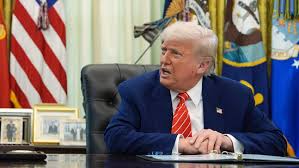‘To protect US from foreign terrorists’: Trump signs travel ban on citizens from 12 countries

In a decisive move aimed at strengthening national security, former U.S. President Donald Trump signed an executive order imposing a travel ban on citizens from 12 countries, citing concerns over terrorism and the need to protect American citizens from foreign threats.
Background of the Travel Ban
The executive order, signed early in Trump’s administration, specifically restricts entry for travelers from nations identified as high-risk due to alleged terrorist connections or insufficient vetting procedures. The list includes countries primarily from the Middle East and Africa. This policy reflects the administration’s broader focus on enhancing border security and combating international terrorism.
Countries Included in the Ban
The travel ban targets citizens from the following 12 countries:
- Iran
- Iraq
- Syria
- Libya
- Somalia
- Yemen
- Sudan
- North Korea
- Venezuela
- Chad
- Eritrea
- Kyrgyzstan
These nations were singled out based on security assessments and intelligence reports that the administration argued demonstrated elevated risks to U.S. safety.
Justification from the Trump Administration
President Trump emphasized that the travel ban is essential to prevent potential terrorists from entering the United States. “Our priority is to protect American families and ensure that foreign terrorists do not find safe harbor on our soil,” Trump said in a statement announcing the policy. The administration argued that many of the countries on the list lack adequate screening processes and pose an ongoing threat to national security.
Domestic and International Reactions
The travel ban sparked significant controversy and legal challenges across the United States. Critics labeled it as discriminatory and unconstitutional, arguing it unfairly targeted predominantly Muslim-majority countries and stoked fear and division within communities. Several courts temporarily blocked the ban, prompting multiple revisions and legal battles.
Internationally, the policy drew mixed reactions. Some allies supported the United States’ right to secure its borders, while others condemned the ban as harmful to diplomatic relations and global cooperation against terrorism.
Impact on Immigration and Refugees
Besides travelers and tourists, the ban also affected immigrants and refugees from the listed countries. Refugee admissions from these nations were suspended or drastically reduced, complicating the resettlement efforts for thousands fleeing conflict zones. Human rights groups expressed deep concern over the humanitarian consequences of the travel restrictions.
Legal Status and Current Situation
Since its inception, the travel ban has undergone various judicial reviews and modifications. While some parts of the ban were upheld by the U.S. Supreme Court, others were struck down or altered. Subsequent administrations have adjusted the policy to align with evolving security and immigration priorities.
Conclusion
The travel ban signed by President Trump marked a significant and controversial chapter in U.S. immigration and security policy. Framed as a protective measure against terrorism, it ignited fierce debates over national security, civil rights, and the nation’s role in global humanitarian efforts. As the U.S. continues to balance safety with openness, the legacy of the travel ban remains a topic of discussion among policymakers, legal experts, and citizens alike.






